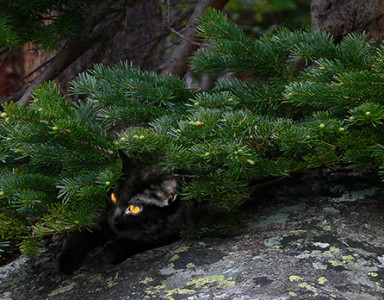
How did the cat in Yeshua’s Cat come to be?
I’d like to say that Mari emerged fully grown from my brow, like Athena from the brow of Zeus, but it didn’t happen that way. She grew slowly as I wrote, born from the personality of the small black cat under the fir tree in the photo, maturing and growing as the book grew, and I with it. She was the author of the book as much as I.
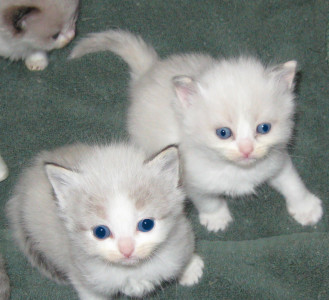
While I was writing Yeshua’s Cat, I was also lending a hand with my sister-in-law Wendy’s Ragdoll cattery. So not only did I have my three rescue cats dancing in and out of my thoughts and over my computer keys, but I also entertained rolling tides of soft-furred queens, kings, princes and princesses, rising and tumbling over the threshold of my room with the rhythms of the day. (They’re gorgeous, by the way: Treasure Mountain Ragdolls).
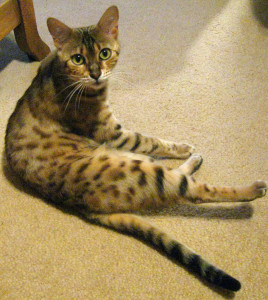
And then there was Chami, the elegant Bengal queen who moved in with me for several weeks while she was between homes. Beautiful and sweet-tempered though she was, she left me feeling as if living with her was a bit like inviting a panther into my bed. I slept lightly in her presence. I suppose the movie Cat Woman deserves mention as well, disappointing as it was. It did send me googling off for more data on the Egyptian Mau. Before seeing the movie, I knew little more than rumors of the breed. Afterwards I was curious enough to want to discover how much of the movie’s hype had been based in fact.

What conclusions I drew about the relationships between the movie and the Mau I no longer remember, but I did stumble onto one amazing thing: the Egyptian Mau cats in the photos looked like the Mari in my mind. I had finished the book by the time I made this discovery, but that made no difference to the identification. Mari was darker than most Egyptian Mau, more like a black or smoke Mau, but her build, her markings, and her face were all theirs–not to mention her affectionate nature, her devotion to her human, her protectiveness, and her hunting skills. So her breed was established, at least in my mind.
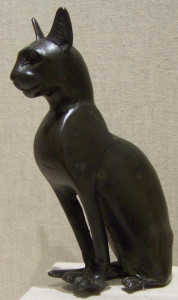
Since Yeshua discovered Mari on the edges of the barren desert surrounding the Dead Sea, I decided that her feline family might have arrived in the area by way of the Nabataean caravans traveling up from Sinai. Or perhaps they were wandering strays from one of the Nabataean cities to the south, or even escapees from a passing camel train. The Nabataeans had originally been tent-dwelling desert shepherds and traders, a mysterious group related to the Bedouin who amassed great wealth over several centuries from their trading networks, and eventually settled down in desert cities. Rock-cut Petra is their most famous settlement, although they also built cities further west and south along the ancient spice routes.
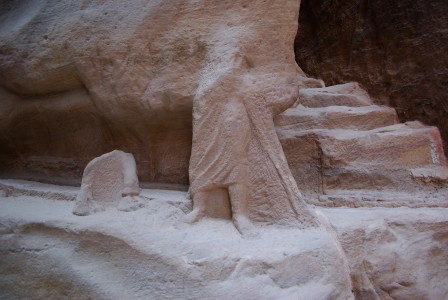

As far as research can tell us, people of 1st C Israel did not keep pets–even dogs–although there was some limited cooperation between the two species. Perhaps the absence of pets was due to Israel’s concern for ritual purity, particularly relating to the ritual uncleanness of scavengers and predators. In any case, their attitude toward animals seemed largely functional. The prophet Ezekiel singled out Bubastis, city of the temple of the cat goddess Bastet, as one of the cities upon which God would pour out his wrath (Ezek 30:17). His mention of this city suggests that the cat goddess was familiar to the people of Israel. She might even have inspired dislike of cats in general. Wealthy Greeks and Romans, however, frequently kept pets, ranging from snakes, monkeys, and fowl to their favorite pet, the dog. But outside of Egypt cats weren’t often accepted as companions until the Common Era.
Cats almost certainly lived on the fringes of Israelite society, even though they may not have been welcomed into people’s homes. By the 1st C C.E., cats had been semi-domesticated throughout the eastern Mediterranean area for several thousand years. Wherever grain was cultivated, rodent control was essential, and cats filled that ecological niche efficiently. They would have been a long-established part of Israel’s environment.
![]()
For Yeshua to have kept company with a cat would certainly have been seen as aberrant behavior, even religiously questionable. But he had his own ways of dealing with such things.
.
.

